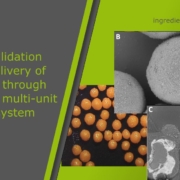Abstract
CELLETS, a new type of adsorbent, have emerged as a promising solution in water treatment. They are particularly effective in fixed-bed column systems for removing persistent organic pollutants, such as synthetic dyes. This summary reflects research published by Suteu et al. [1].
Fixed-bed adsorption is a well-established filtration method. It allows continuous treatment of contaminated water by passing it through a packed column filled with adsorbent material. Its advantages include high throughput, easy operation, scalability, and adaptability to various industrial settings. However, one enduring challenge is the effective removal of dyes. These molecules, especially from pharmaceutical and chemical effluents, have complex aromatic structures, high chemical stability, and resistance to biodegradation.
Dyes, both cationic and anionic, are not only visually polluting but also potentially toxic, mutagenic, or carcinogenic. In pharmaceutical wastewater, even trace levels can disrupt downstream processes or contaminate the environment. Consequently, this raises concerns for human and ecological health. Conventional adsorbents, such as activated carbon and ion-exchange resins, are effective but have limitations. They are costly, inefficient to regenerate, and prone to fouling.
In this context, microcrystalline cellulose (MCC) cellets offer a novel approach. Their spherical shape, uniform particle size, mechanical resilience, and hydrophilic surface make them suitable for packed-bed applications. This study examines cellets’ performance in removing representative dyes from aqueous media. By focusing on CELLETS as a new type of adsorbent, the research addresses a critical gap. It offers a sustainable, cost-effective, and scalable solution for dye-laden industrial wastewater, particularly under the stringent requirements of the pharmaceutical sector.
Introduction
Fixed-bed column techniques are essential filtration systems. In these systems, a fluid stream passes continuously through a packed bed of adsorbent material. They are valued for operational simplicity, scalability, and continuous processing—key features for industrial and pharmaceutical wastewater treatment. However, removing dyes remains a major challenge. These molecules are complex, often toxic, and chemically stable, resisting conventional treatment. In pharmaceutical effluents, even trace dye residues can pose serious safety risks and violate strict regulatory limits.
This study investigates CELLETS® as a new type of adsorbent in fixed-bed columns. CELLETS® are spherical microcrystalline cellulose pellets. They are tested for their ability to remove both cationic and anionic dyes from aqueous streams. Thanks to their uniform geometry, mechanical strength, and biocompatibility, CELLETS® show promise in overcoming the limitations of current dye removal methods.
Use of cellulose CELLETS as new type of adsorbent
CELLETS® are uniformly sized spherical pellets made of microcrystalline cellulose. They are typically available in diameters ranging from 100 µm to 500 µm. Their narrow size distribution, smooth surface, and water-insoluble nature reduce friability and minimize clogging. As a result, they are ideal for packed-bed applications [1]. In this study, CELLETS® 200 and CELLETS® 350 served as the fixed-bed medium.
First, the authors characterized their morphology, including sphericity, porosity, and mechanical stability. Then, they applied CELLETS® in fixed-bed column experiments to remove model dyes: Methylene Blue (cationic) and Brilliant Red HE‑3B (anionic).
Additionally, batch experiments were performed to establish equilibrium, kinetics, and isotherm parameters before column testing. In the fixed-bed setup, breakthrough curves were recorded under different operational conditions, such as flow rate, bed height, and influent dye concentration. These tests revealed how CELLETS® perform under dynamic conditions.
Key Findings
The study revealed that CELLETS® exhibit strong adsorption capabilities for both cationic and anionic dyes, performing comparably to other biosorbents used in dynamic treatment systems. The breakthrough curves demonstrated that column performance could be modulated by operational parameters: increasing bed height extended breakthrough time and improved capacity, while higher flow rates accelerated breakthrough due to mass transfer limitations. Mathematical models commonly used for fixed-bed adsorption (Thomas, Yoon–Nelson, Bohart–Adams) fit the experimental data well, enabling the extraction of key design parameters for scale-up. Notably, CELLETS® displayed mechanical robustness, sustaining repeated adsorption–desorption cycles (through mild acid or ethanol washout) with over 80 % retention of initial capacity [1,2]. Their spherical geometry resulted in low pressure drop and uniform flow, mitigating common issues like channeling and bed compaction.
Conclusion & Outlook
This study convincingly positions CELLETS® as a compelling new type of adsorbent for dye removal in fixed-bed systems. Their blend of favorable adsorptive properties, structural resilience, and hydraulic stability make them attractive for continuous water treatment processes, especially where regulatory constraints demand high effluent quality. The renewable nature of microcrystalline cellulose adds environmental value, aligning with sustainable treatment practices.
Future research directions include enhancing CELLETS®’ adsorption capacity via surface functionalization (e.g., with carboxyl or amine moieties) to target specific pollutants, extending studies with real industrial and pharmaceutical effluents, and integrating CELLETS®-based systems with complementary treatment processes such as membrane filtration or advanced oxidation. Pilot-scale studies and economic assessments will be essential to advance CELLETS® from lab-scale validation to industrial adoption.
By demonstrating CELLETS® as new type of adsorbent, this publication highlights their promising role in addressing the persistent challenge of dye removal in fixed-bed column systems—offering a scalable, effective, and sustainable solution for complex aqueous pollution.
References
[1] Environmental Engineering and Management Journal, 2015, Vol.14, No. 3, 525-532; http://www.eemj.icpm.tuiasi.ro/pdfs/vol14/no3/full/4_998_Suteu_14.pdf
[2] Fixed-bed-column studies for methylene blue removal by CELLETS
[3] Renewable Resource Biosorbents: Granulated Cellulose CELLETS 200 for Organic Pollutants Adsorption in Fixed-Bed Column Systems, Separations 2023, 10(2), 143; doi:10.3390/separations10020143






 adobe firefly
adobe firefly 

